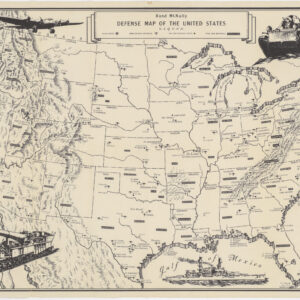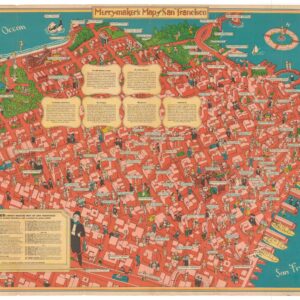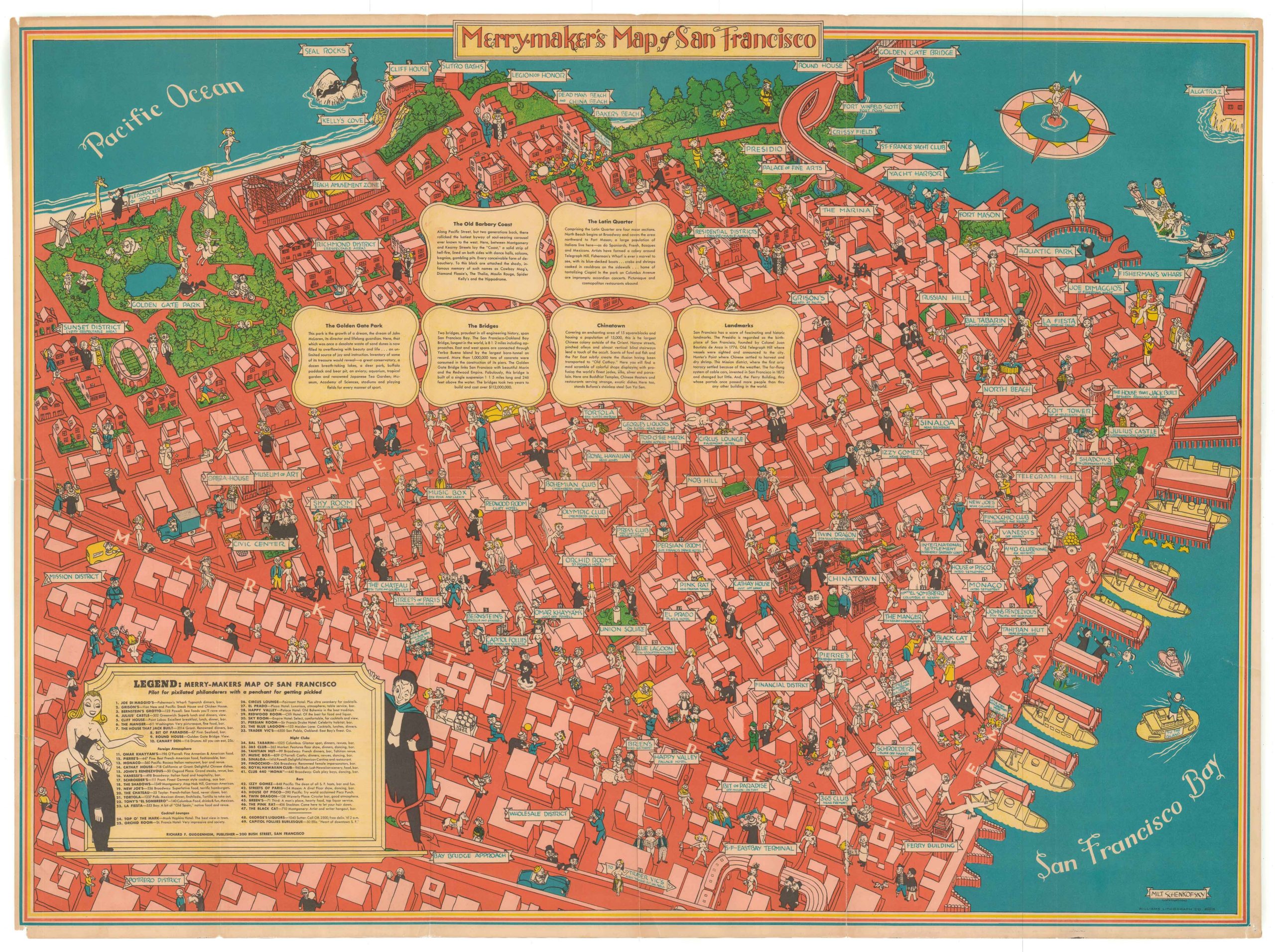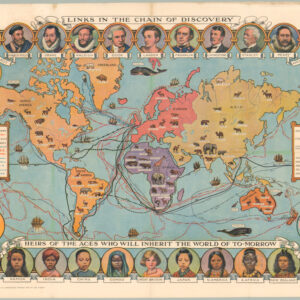1939 Goodacre poster-map presenting the missions of California as an important part of the state’s historical heritage.
Romance of the Missions. California
Out of stock
Description
This evocative 1930s poster by illustrator WJ Goodacre depicts not only the California coastline and the location of the many old Spanish missions along it, but also provides the viewer with comprehensive texts to elucidate the background, purpose, and history of each mission. The map has been printed on yellow paper using brownish-purple ink with red highlights. Each of the respective mission buildings are drawn as little vignettes onto the underlying map of the California coast, and descriptions of each one have been placed alongside them. These descriptions are quite informative, providing historical details on each the mission. This illustrated string of missions stretches from San Diego de Alcala in the south to the San Francisco Solano Mission in the north, which is located in modern Sonoma. There is a degree of chronological progression that follows the northward expansion of the missions, but to this we shall return below.
In addition to descriptions and depictions of each mission, the poster includes several depictions of the most important and influential of all the padres associated with the California mission phenomenon: the controversial Padre Junipero Serra. Like this biographical map of Serra’s life and work, Goodacre’s mission map includes a prominent portrait of Serra, found in the upper right corner. In the lower left corner, we see Padre Serra in action, gazing across the Californian frontier. This romanticized image also has a short biographical text, which explains Padre Serra’s decisive role in founding the California missions (more on Serra below).
A total of twenty-one missions have been depicted on the map. If we follow these from south to north, we note that each mission has been numbered, but that the numbers do not follow in order. The numbering is in fact chronological and provides a simple historical framework for understanding what areas the Franciscans settled when. Despite the visually incoherent numbering, the general trend of a movement from south to north remains clear.
A final note should be made on the inclusion of the ‘Old Mission Trail’ as a dotted red line, with crosses denoting the location of each mission along the way. For interesting comparison purposes, the mapmaker has included a continuous brown line showing how the modern Highway 101 follows roughly the same route as the old Camino Real. A the very bottom of the map, a densely written scroll gives us a historical recap of Spanish settlement in the region.
Padre Serra
Padre Junipero Serra was born in 1715 on the Balearic island of Mallorca. Upon completing his studies in Palma, Serra joined the Franciscan Order where he also took the name Junipero, in honour of one of St Francis’ most ardent followers. The following year, he was ordained a priest. After almost 20 years as a priest, Serra travelled to the New World where he hoped to convert indigenous peoples to the true faith. He arrived in Vera Cruz on the Gulf coast and continued from here, on foot, to Mexico City. His mission took him to many different and often remote places throughout Mexico, where he gradually became a well-known and respected figure. In 1767, almost twenty years after his initial arrival in Mexico, Serra was appointed head of the Catholic missions in Lower California. Two years later, this responsibility was expanded to included Upper California as well. Moving north from Lower California, Serra arrived in the area of San Diego in the summer 1769 and proceeded to found a mission there in mid-July. This would be the first of twenty-one missions founded by Franciscans along the Californian coast – a stretch of more than 600 miles.
Serra’s legacy is controversial, to say the least. Converting large numbers of indigenous peoples during his almost 35 years of missionary work, Serra was in many ways the key that opened California to external settlement. Even during his life-time, he was renowned for his sincere humility, deep faith, and diligent work-ethic. He was described as a man of almost saintly character, who deliberately avoided honors from the Church or other personal glory. Serra died in California in 1784, at the age of 70, but he is often credited as the man who instigated the colonization of California, at the expense of its native inhabitants and cultures. Indeed the poster’s text states that he “…prepared the way for the coming of the white race, for the Argonauts, the covered wagons and the birth of the Golden State.”
Context is everything
Starting in the late 18th century, some twenty-one Spanish missions were founded by Franciscan friars along the coast of California between 1769 and 1823. The intention was to convert the native population to Catholicism and extend Spain’s colonial empire northward into the virgin territory that the pioneer settlers called Alta (Upper) California.
The missions were built a day’s journey on horseback apart, so that travelers could move safely between them, and they were usually positioned very carefully in the landscape. In many cases, a small contingent of Spanish soldiers would be stationed there alongside the Padres. While part of their history is one of violence against the indigenous population, another part of the story is that the soldiers brought with many of the skills that were needed for settler to survive here long-term. This included things such as horsemanship, cattle ranching, and blacksmithing.
The route between the missions came to be known as the Camino Real (corresponding roughly to Highway 101 today). As such, the missions also served as crucial infrastructure nodes in an undeveloped and largely unexplored region of Spanish North America. Arriving in earnest during the late 1700s, Spanish settlers decimated the indigenous tribes through smallpox, servitude, and other depredations. Any resistance was dealt with harshly, but local tribes such as the Salinan were also housed, fed, and educated – either as catechists or cattle drivers. Moreover, most of the Spanish settlements – be they the presidios built for the army, evolving pueblos, or indeed the California missions – gradually developed into some of the great West Coast cities (e.g. Los Angeles, San Francisco, San Diego, San Jose etc.), which today make California the nation’s most populous state.
Following Mexican independence in 1821, the missions were partly secularized. Twenty-seven years later, at the end of the Mexican-American War and with the signing of the Treaty of Guadalupe Hidalgo (1848), the California Gold Rush ensued, and in 1850 California achieved statehood. For a long time after this, the missions were largely forgotten and left to deteriorate as relics of a bygone era. In the 1870s and 80s, however, the ruined mission buildings regained some popularity, in part due to the enthusiasm propagated by writers like Mark Twain and Bret Harte. Increasingly they were viewed as part of California’s heritage, and particularly in Southern California, missions became cornerstones of a new regional identity.
While most people acknowledge them as an important part of California’s history today, there continues to be valid critique of the “mission myth” as an historical narrative that omits uncomfortable truths.
Cartographer(s):
William Johnson Goodacre was a commercial artist who emigrated to California from England in 1924. Settling in Santa Barbara, he produced a range of important maps and book illustrations that often embodied a more or less explicit lesson to be learned. This included a map of Santa Barbara and a map on the flags of California. His most famous poster map is probably the “Romance of the Missions” poster from the mid 1930s. Goodacre’s original maps are generally scarce on the market.
Condition Description
Excellent. Small tear at bottom.
References
OCLC 21188795.






![Flag Map of California [Signed in pencil by W.J. Goodacre]](https://neatlinemaps.com/wp-content/uploads/2022/01/NL-01134_thumbnail-scaled-300x300.jpg)
![Flag Map of California [Signed in pencil by W.J. Goodacre]](https://neatlinemaps.com/wp-content/uploads/2022/01/NL-01134_thumbnail-scaled.jpg)